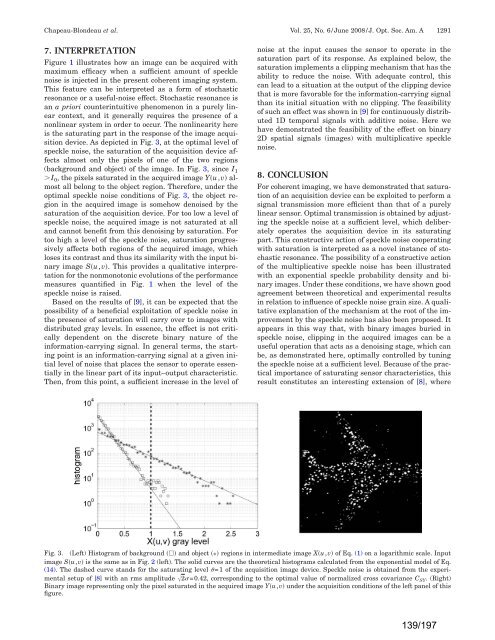a la physique de l'information - Lisa - Université d'Angers
a la physique de l'information - Lisa - Université d'Angers
a la physique de l'information - Lisa - Université d'Angers
You also want an ePaper? Increase the reach of your titles
YUMPU automatically turns print PDFs into web optimized ePapers that Google loves.
Chapeau-Blon<strong>de</strong>au et al. Vol. 25, No. 6/June 2008/J. Opt. Soc. Am. A 1291<br />
7. INTERPRETATION<br />
Figure 1 illustrates how an image can be acquired with<br />
maximum efficacy when a sufficient amount of speckle<br />
noise is injected in the present coherent imaging system.<br />
This feature can be interpreted as a form of stochastic<br />
resonance or a useful-noise effect. Stochastic resonance is<br />
an a priori counterintuitive phenomenon in a purely linear<br />
context, and it generally requires the presence of a<br />
nonlinear system in or<strong>de</strong>r to occur. The nonlinearity here<br />
is the saturating part in the response of the image acquisition<br />
<strong>de</strong>vice. As <strong>de</strong>picted in Fig. 3, at the optimal level of<br />
speckle noise, the saturation of the acquisition <strong>de</strong>vice affects<br />
almost only the pixels of one of the two regions<br />
(background and object) of the image. In Fig. 3, since I 1<br />
I 0, the pixels saturated in the acquired image Yu,v almost<br />
all belong to the object region. Therefore, un<strong>de</strong>r the<br />
optimal speckle noise conditions of Fig. 3, the object region<br />
in the acquired image is somehow <strong>de</strong>noised by the<br />
saturation of the acquisition <strong>de</strong>vice. For too low a level of<br />
speckle noise, the acquired image is not saturated at all<br />
and cannot benefit from this <strong>de</strong>noising by saturation. For<br />
too high a level of the speckle noise, saturation progressively<br />
affects both regions of the acquired image, which<br />
loses its contrast and thus its simi<strong>la</strong>rity with the input binary<br />
image Su,v. This provi<strong>de</strong>s a qualitative interpretation<br />
for the nonmonotonic evolutions of the performance<br />
measures quantified in Fig. 1 when the level of the<br />
speckle noise is raised.<br />
Based on the results of [9], it can be expected that the<br />
possibility of a beneficial exploitation of speckle noise in<br />
the presence of saturation will carry over to images with<br />
distributed gray levels. In essence, the effect is not critically<br />
<strong>de</strong>pen<strong>de</strong>nt on the discrete binary nature of the<br />
information-carrying signal. In general terms, the starting<br />
point is an information-carrying signal at a given initial<br />
level of noise that p<strong>la</strong>ces the sensor to operate essentially<br />
in the linear part of its input–output characteristic.<br />
Then, from this point, a sufficient increase in the level of<br />
noise at the input causes the sensor to operate in the<br />
saturation part of its response. As exp<strong>la</strong>ined below, the<br />
saturation implements a clipping mechanism that has the<br />
ability to reduce the noise. With a<strong>de</strong>quate control, this<br />
can lead to a situation at the output of the clipping <strong>de</strong>vice<br />
that is more favorable for the information-carrying signal<br />
than its initial situation with no clipping. The feasibility<br />
of such an effect was shown in [9] for continuously distributed<br />
1D temporal signals with additive noise. Here we<br />
have <strong>de</strong>monstrated the feasibility of the effect on binary<br />
2D spatial signals (images) with multiplicative speckle<br />
noise.<br />
8. CONCLUSION<br />
For coherent imaging, we have <strong>de</strong>monstrated that saturation<br />
of an acquisition <strong>de</strong>vice can be exploited to perform a<br />
signal transmission more efficient than that of a purely<br />
linear sensor. Optimal transmission is obtained by adjusting<br />
the speckle noise at a sufficient level, which <strong>de</strong>liberately<br />
operates the acquisition <strong>de</strong>vice in its saturating<br />
part. This constructive action of speckle noise cooperating<br />
with saturation is interpreted as a novel instance of stochastic<br />
resonance. The possibility of a constructive action<br />
of the multiplicative speckle noise has been illustrated<br />
with an exponential speckle probability <strong>de</strong>nsity and binary<br />
images. Un<strong>de</strong>r these conditions, we have shown good<br />
agreement between theoretical and experimental results<br />
in re<strong>la</strong>tion to influence of speckle noise grain size. A qualitative<br />
exp<strong>la</strong>nation of the mechanism at the root of the improvement<br />
by the speckle noise has also been proposed. It<br />
appears in this way that, with binary images buried in<br />
speckle noise, clipping in the acquired images can be a<br />
useful operation that acts as a <strong>de</strong>noising stage, which can<br />
be, as <strong>de</strong>monstrated here, optimally controlled by tuning<br />
the speckle noise at a sufficient level. Because of the practical<br />
importance of saturating sensor characteristics, this<br />
result constitutes an interesting extension of [8], where<br />
Fig. 3. (Left) Histogram of background and object * regions in intermediate image Xu,v of Eq. (1) on a logarithmic scale. Input<br />
image Su,v is the same as in Fig. 2 (left). The solid curves are the theoretical histograms calcu<strong>la</strong>ted from the exponential mo<strong>de</strong>l of Eq.<br />
(14). The dashed curve stands for the saturating level =1 of the acquisition image <strong>de</strong>vice. Speckle noise is obtained from the experimental<br />
setup of [8] with an rms amplitu<strong>de</strong> 2=0.42, corresponding to the optimal value of normalized cross covariance C SY. (Right)<br />
Binary image representing only the pixel saturated in the acquired image Yu,v un<strong>de</strong>r the acquisition conditions of the left panel of this<br />
figure.<br />
139/197


